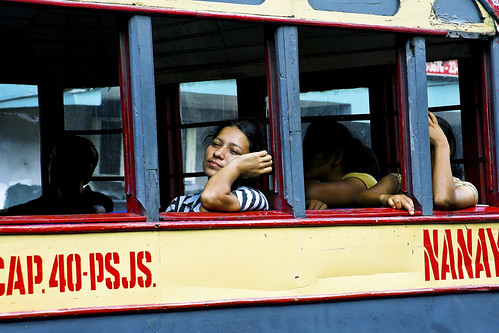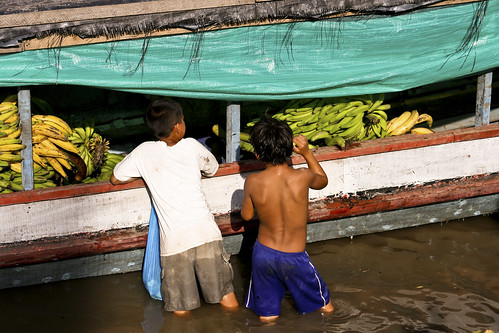When selecting a new dSLR camera, many people seem to look at the latest offerings, attempt to compare their many features, and determine which one, in or near their price range, is “better.” But this is the backwards way to approach it. Of course a continuous burst rate of of 126 JPEGs at 8 frames per second is “better” than 58 frames at 5.3 frames per second. But do you need the ability to take 126 consecutive images in 15.75 continuous seconds? Ever? Certainly the ability to to control both the method and the sensitivity of AI Servo Tracking is impressive and powerful, but do you even understand it, wish to learn about it, need it, and will you ever use it? If a camera’s features don’t fit your needs as a photographer, it is not a better camera for you. In fact, it may be a worse camera for you because its complexities and options may serve to work against you and your image making.

Iquitos, Peru
When you are trying to determine which new dSLR camera to purchase or upgrade to, you need to first consider and determine your needs, and then see which camera fills those needs. Not the other way around where you look at the new features and determine if you really need or will use them.
For example, I began shooting with a Rebel XT and took it on an extended trip where I shot lots of outdoor dance and festivals (see the Peru and Dance galleries here for the results – those are all shot with a Rebel XT.) I soon discovered this camera wasn’t fulfilling my growing needs and I made a mental list of what my next camera needed:
- more focus points which are more strategically positioned (the Rebel XT only has 7 focus points in a simple cross pattern which did not suit the way I focus and compose)
- faster frame rate in continuous shooting mode (it only has 3 fps which wasn’t good enough for catching a good burst at the peak of action)
- better sealed body (I ended up in several very dusty or wet situations)
- integrated sensor cleaning (see “dusty or wet situations” above)
- more megapixels (the 8 MP of the XT just weren’t sufficient when it came to cropping and post-processing)
- battery with longer capacity (I used it on weekend trips to the middle of nowhere with no electricity, but didn’t want to have to buy and take more than 3 batteries)
- larger LCD screen to better review photos (the XT has a tiny screen)
- grid in the viewfinder (I just can’t keep it straight sometimes)

Iquitos, Peru
These are the features I looked for in my next camera. I didn’t work backwards and wonder, “Do I need or will I ever need auto lighting optimizer and highlight tone priority?” If I had exposure issues on my list, I would have looked for these kinds of features, but I didn’t. I didn’t wonder, “Do I need multiple flash remote firing? Should I worry about that?” That wasn’t on my list because it wasn’t a need I ran into, ever, in months of shooting. I don’t even own multiple flashes and wish to minimize using the one. I didn’t ask myself, “Do I need an extensively redesigned focus system with AF Point Expansion and Zone focusing?” I nearly always choose my own focus point – I don’t want the camera choosing the closest point which is bound to be a dancer’s flying hand and not their face, so I don’t need that. No matter how awesome and advanced it is, even if the subjects are moving. I’m pretty quick with the focus point selection, I just need more and better placed focus points. If you haven’t run into a need for certain features in your months or years of extensive shooting, you aren’t going to suddenly need it just because it is now offered on a camera. Sit down and make your list, then look at the cameras’ offerings.
And please be aware, no new camera will help you instantly create better photos. Or better yet, all of the latest cameras will help you take better photos, but equally so, none any better than the others. If you wish to take better photos, just chose one of the cameras and get out and shoot. Learn how to use the basic settings (aperture, shutter speed, ISO, focusing modes and focus points, exposure metering modes, histograms) and then concentrate on composition and telling a story through your images. Get a book like Bryan Peterson’s newly updated Understanding Exposure to get a handle on the essential functions and relationships of aperture, shutter speed, and ISO. Or have a look at my Full Stop e-book camera guides for various Canon and Nikon dSLR cameras! And see the following posts to help you on your way:

Pucallpa, Peru
Need a lens to go with your new camera? Read about choosing a lens other than the kit lens in this post Why You Shouldn’t Buy the Kit Lens, and learn about the Best Lenses for Travel Photography here.
If you are interested in researching or purchasing the equipment or books I use, discuss, or recommend, I would appreciate it if you use this referral link to Amazon. Your price will be the same, and it will help support my blog and my work. Thanks! And for those of you across the pond, click here for my referral link to Amazon UK. If you are in another country, click on one of my Amazon links, scroll to the bottom of the page, and click on your country for your local Amazon.


This comment was moved from the home page to here:
Hello!
S.O.S!
I haven’t used an SLR camera ,but I’m planning to buy as a gift to my daughter who’s having her first baby (my 1st grandbaby!) comes June. May I request for your advice on what kind to buy? (including needed accessories) I’ll appreciate your help on this as I want a camera my daughter will treasure for life. Thank you very much and a Prosperous New Year to you and to your family!
Lorna
ANSWER:
Hello, the short answer is, go with the Canon T3i or the Nikon D5100. They are each high-quality and highly capable cameras, but are also designed for new and intermediate dSLR users. This allows them to be a bit easier to start out with than the upper level cameras, yet they share the same image quality and many of the capabilities of those higher models.
Also, be aware that no digital camera will last a lifetime. While it should last at least 5 years if not many more, cameras become outdated and obsolete, like any other electronic, and can start to “wear out” and malfunction after a certain number of years.
As far as accessories, have a look at this post:
http://blog.dojoklo.com/2011/04/01/top-10-accessories-for-your-canon-rebel-t3i-eos-600d/
It lists accessories for the T3i, but the Nikon ones will be similar – just look for the Nikon version of the battery, lens, etc.